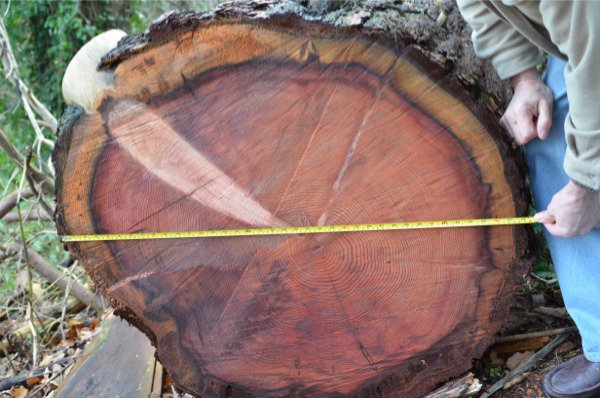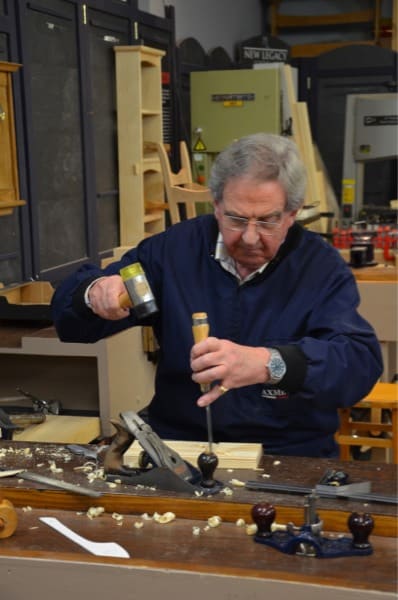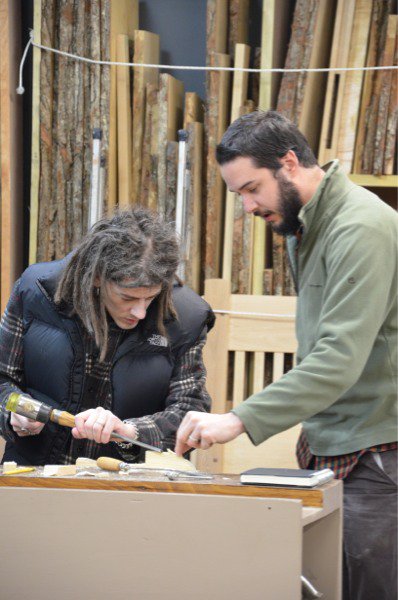Discovering Wood



Today I was astounded by a piece of 2” by 4” Scandinavian Redwood I cut for planing practice for the students. Actually, two types of wood. The other being spruce. The thing that struck me was that the 2” x 4” pine had 150 growth rings over 70mm (2 3/4”). So this specific tree still standing a year or less ago measure 5 1/2” in diameter and it was 150 years old. In the grounds of the castle are American Redwoods 113 years old that measure 37” in diameter. Another piece of spruce I had in a 2” by 4” section had 20 growth rings to reach the same size as the Scandinavian Redwood. Anyway, I that was so interesting. Oh, and then there is the beech tree that was 150 years old also.





Another interesting thing was the wonderful day we had Discovering Woodworking in the workshop today. I love it when students come with almost no knowledge because there is so little we need to do to dismantle knowledge from the great world of misinformation. We were able to give direct information about the reality there is in one simple fact about traditional hand work and that is that most of what we hand tool enthusiasts do we can do with about ten hand tools. We will need more as we grow, but to get going on joints and planing wood smooth, making hundreds of projects and such, we can do exceedingly well with just a box full of hand tools. Add into that equation the reality that we need to know how to make only about half a dozen joints to make almost every type of structure and we simplify even more. So, what do machines do that we can’t do so readily with hand tools? They do what they do best and that is they give us the ability to convert large sections into small sections. So that’s what we learned as we split wood for spatulas and planed 2×4’s to learn how a hand plane like the Stanley #4 planes wood silky smooth. We learned that there are many other joints too and that machines do do things that can be difficult by hand but that for most of real woodworking we can do it efficiently by hand. We compared heavy planes with lightweight planes and we oohed and aahd over the differences in the hand. Splitting wood for a spatula introduced us to grain inside rather than just fingertip sensing and visual reference. We planed and chiseled with affordable tools and the joints we all made held together without glue, screw or nails. The questions came in by the dozen and it was as if we were all sitting on the edge of our seats throughout the whole day except for most of the day we were actually standing at the benches making.
I know we all felt what Walter Rose felt when the time came for bed. He wrote something like “beneath the bed rose quite content.” Meaning he was in bed after a hard days work looking up a the rose, the light fitting in the ceiling, feeling contented.


Paul this is interesting and truthfully I have a better outlook and attitude about pine since discovering you, and finding I like it more and more.
I bet the class is a ball and looks so relaxing yet learning a lot, wish I could be there. Good luck with the new class and looking forward to hearing more about it as you go.
Thanks for sharing !
Steve
European redwood was a lifesaver for Britain. It resists rot and comes in great sizes too. Getting some of the Russian redwood as a boy was phenomenal. No knots for thirty feet, annual rings two to the millimetre, straight grained, planable almost any which way you chose. Almost all the windows and doors were made from redwood as well as internal joinery. We made staircases from redwood that were a joy to make. Now they use MDF for paint grade stairs. I ask you.
I think the important thing to see here is that. Pine is not a cheap trash wood but is and has been a wonderful provision through centuries, just like oak or mahogany but even more so for some. It’s more what we did to make it cheap or should I say cheapen it in our view rather than it being cheap. I will always be grateful for the smell. You know if you mix a cup of pine Sol with half a gallon of water and spray it on any insect like roaches, or invading ants to your pantry, it kills them within seconds. Pine sol is just pine oil. It’s totally biodegradable. We used it for years to control fire ants.
Paul, is ‘European Redwood’ what I would call Scots Pine?
I’ve come across the idea that pine is cheap trash as well, and so is beech wood to some extent. I’m currently making a bed using this and getting all kinds of funny looks at work. Mind you, that may be because I’m insisting on using tenons and pegs ofr the joins and not ‘sensible’ metal connectors…
Yes it is. Phil and I were discussing this yesterday.redwood will vary depending on density of growth, canopy and so on.
Sorry you get peer pressure from machinists, but stick with it. Your life will find fulfilment they will never know, most likely!
Andy, I love Pine. Post a picture of your bed in the forums when it is complete. I’ve made several pieces of furniture using pine. Growing up, the area where I lived was mostly pine forrest. Many a day as a child I spent climbing and playing in those wonderful forrest. So I’ve been around it all my life and even now, my house is completely paneled in pine. On a warm day when I come home from work the whole house has that rich pine aroma and I remember those days as a youth. Seasoned Pine is a joy to work with and it’s normally my first choice.
thanks for posting updates on how the first class of the year is going i have two observations forgive me for being picky the first is, why are the students using the soft side of their hammers for chiseling (i know picky) and also they all seem to be freezing in their coats you must work them harder 😉
They did well whichever way they turned the hammer so I let them sweat the big stuff.
i’m sure they did who couldn’t in that enviroment ,one day i hope to find out first hand
Discovery – that’s what I think that these two days are about. The students will figure out what end of the hammer to use. Lucky them for have such a great teacher who knows when to step back and letting them have an opportunity for discovery!
The great thing they get to learn is make something with their own hands and at like Walter Rose said, at the end of they day they can see their time investment and hard work.
The grounds of the Castle and North Wales must be great places to learn woodworking and enjoy the outdoors (if you are an outdoors type, as I am). I enjoy your writing and the perspicacity and insight you bring to it with regard to nature, trees, and craftsmanship in today’s society.
Can’t wait for the day to come to be one of the fortunate to be there in class and learn.
Yup, I am spoiled, but at least I can share it all with others as best I can.